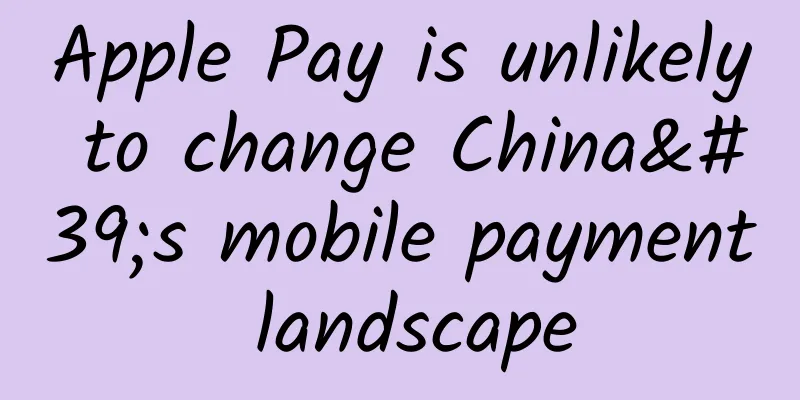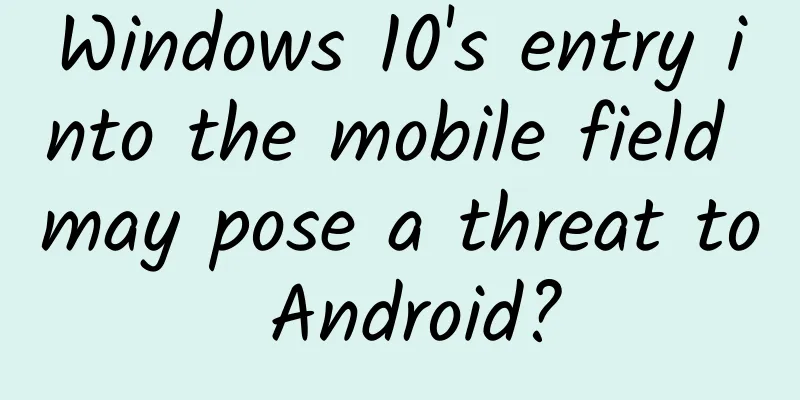Apple Pay is unlikely to change China's mobile payment landscape

|
Almost everyone is certain that this is Apple's most failed product launch since 2007, with the iPhone 6 and iPhone 6 Plus "reinventing the ugly end", and the Apple Watch which Apple itself hasn't figured out. But this is not a problem for Apple, because at the launch event Apple released its most promising product in the past two years, Apple Pay. Although it only lasted ten minutes at the event, this may be a huge source of revenue for Apple in the future and a backbone supporting Apple's stock price. 1. Analysis of Apple Pay Currently, most of Apple's revenue comes from the sale of hardware, which is extremely profitable, and a small part comes from the revenue sharing between iTunes and AppStore and developers and record companies. In the process of developing iPod iTunes and iOS AppStore downloads, Apple has accumulated a large number of credit card users. There are already 330 million iPhone users worldwide, and these 300 million backup users may all be Apple Pay users. The fingerprint recognition Touch ID added to the iPhone 5s has become an important chess piece in Apple's layout in the field of payment: fingerprint recognition is a biometric recognition and is currently a safe, efficient and convenient payment method (in the field of payment, security and convenience are a pair of difficult problems. Fewer steps and simpler verification will inevitably bring security risks. Biometric recognition solves this problem to a certain extent). The iPhone 6 only needs to add an NFC chip to complete the last link of payment, and a perfect closed payment loop is formed. In fact, Apple did this, and planned it for a long time, not giving competitors time to react (from this point of view, Apple Pay is the product with the most Steve Jobs spirit in this conference). Apple Pay was born in its prime: it cooperated with the three largest card issuers, VISA, MasterCard and American Express, and joined the six major banks, covering 22,000 retailers. Apple's introduction of NFC payment instantly changed the direction and future of the entire US payment industry. Whether it is Google Wallet led by Google, or Paypal, Square and other companies that focus on online payment or NFC, they will undoubtedly have to follow Apple's footsteps, not for anything else, but because it is called Apple. Apple's offline payment uses NFC technology, uses Touch ID for encryption and verification, and puts user information in the "Secure Element", which is similar to the principle of putting Touch ID information in the "Secure Enclave". The user's payment information will be stored on a chip inside the phone. Apple will not track payment information such as transaction amount and location. Transaction information is only known to banks and merchants. Because NFC payment requires the cooperation of POS machines that can read NFC chips, transforming old card POS machines is a huge project. Since Apple has so many partners from the beginning, it can be seen that Apple has put a lot of effort in merchant cooperation negotiations, so that it can list so many partners on the stage. Apple Pay can also be used for online payments, but instead of going through NFC, you can directly swipe your credit card by verifying your fingerprint. Apple's payment is equivalent to card binding. There is no concept of capital pool. Transactions are only between merchants and users. Apple plays the role of a channel. In fact, this is similar to the quick payment pioneered by Alipay. Apple Pay is said to charge banks a handling fee. This huge amount of mobile payment is naturally a big business, which may not be inferior to the income from selling software in the AppStore. But this also shows that apart from payment, Apple will not enter the field of Internet finance for the time being. (In WeChat 5.4, WeChat Pay has WeChat Wallet and a capital pool. WeChat Pay will have greater actions in Internet finance.) 2. What impact does Apple Pay have on mobile payments in China? China UnionPay is currently actively contacting Apple, hoping to jointly establish standards in China. There are currently two forces in China's offline payment. One is NFC payment, which is promoted by UnionPay, operators and some NFC manufacturers; the other is mobile payment through Internet channels such as scanning codes and sound waves, which is promoted by Internet companies such as Alipay and WeChat. Alipay and WeChat have become more popular than NFC payment through the taxi payment war, investment and transformation of shopping mall payment environment. In the NFC camp, UnionPay and operators have been fighting for dominance, and offline POS machine transformation has been slow to get on track. Although UnionPay's QuickPass has been promoted, it has not been joined by players like Apple and has been in the trial stage. Some manufacturers who originally added NFC functions to their mobile phones have also withdrawn due to the delay in commercialization. Xiaomi 3 and Meizu MX3 both have NFC payment functions, and the subsequent models Xiaomi 4 and MX4 have cancelled the NFC module. Since Apple supports the NFC mode, it can influence at least half of the world, and NFC will set off a whirlwind in the future. UnionPay actively shows its goodwill to Apple, and naturally wants to take advantage of Apple's momentum to promote UnionPay's own NFC flash payment as the Chinese standard. My judgment is that this negotiation will not succeed, and UnionPay and Apple will not reach a cooperation in China. According to Apple's strong style, since it has its own standards and closed loop, why can it allow others to interfere? UnionPay's position in China also shows that UnionPay will not give up too much in terms of interests to Apple. UnionPay has never been soft-handed when it came to Alipay. It is not difficult to draw this conclusion by referring to the difficult negotiations between China Mobile and Apple for several years. Speaking of contacts, since Apple is going to release iPhone 6 with payment function, it must have contacted the leading manufacturers in the market before the release. As far as I know, before the release of iPhone 6, Apple contacted Alipay and other companies to reveal some major standards. Can NFC payment promoted by Apple Pay gain an advantage in China? It seems difficult now. NFC payment requires the modification of a large number of POS machines, and the modification cost of each machine is 1,000 yuan. There are currently 10 million POS machines in China, and 3 million of them have NFC functions. The modification cost alone is 7 billion yuan. Who will pay for this? In the NFC payment chain, UnionPay, operators and mobile phone companies such as Apple all want to dominate. UnionPay and China Mobile have just unified the NFC technology standards, and now Apple's Apple Pay standard has come out, and merchants are divided. In the mobile payment such as scanning code dominated by Internet companies, Alipay Wallet and WeChat Pay are two major players. Although there is competition, the fundamental purpose of the two is the same. Whether it is through sound waves or QR codes, they are both means of connecting the world. The advantage of Internet mobile payment is that the transformation cost is low. Through the promotion of Didi Kuaidi taxi, it quickly became popular across the country. However, unlike the Internet where one call gets a hundred responses, offline payment requires a lot of patience and time for ground promotion. Alipay Wallet, which is good at ground promotion, runs faster than WeChat Pay and is one step ahead in the fields of public transportation and hospitals. However, the Internet companies are not the best at offline business, so for mobile payment, the "contractors" and "bricklayers" of the traditional era have more patience and advantages. Faced with nearly 30 trillion yuan in card payment, the mobile payment industry chain may not produce traditional giants, and both Internet companies and NFC industry chains can get a share of the pie. However, although they are more optimistic about scanning code payment, Internet companies have not given up trying NFC. Alipay Wallet 8.0 has added NFC payment, and has also cooperated with Huawei Mate7 with fingerprint payment. No matter which side the balance of mobile payment falls to in the future, smart Internet companies will not fall behind. As a winner of Toutiao's Qingyun Plan and Baijiahao's Bai+ Plan, the 2019 Baidu Digital Author of the Year, the Baijiahao's Most Popular Author in the Technology Field, the 2019 Sogou Technology and Culture Author, and the 2021 Baijiahao Quarterly Influential Creator, he has won many awards, including the 2013 Sohu Best Industry Media Person, the 2015 China New Media Entrepreneurship Competition Beijing Third Place, the 2015 Guangmang Experience Award, the 2015 China New Media Entrepreneurship Competition Finals Third Place, and the 2018 Baidu Dynamic Annual Powerful Celebrity. |
<<: WeChat still has a chance of commercialization, but it is too early to predict its failure
>>: iPhone 6: Bigger but less classy
Recommend
During the Spring Festival, children must be protected from the safety hazards of fireworks and firecrackers!
Fireworks and firecrackers often cause injuries d...
iOS 9 Learn more every day Day 1: Search API
Prior to iOS 9, Spotlight could only search for a...
Has the secret of crop circles been solved long ago?
If you see strange patterns in a wheat field, you...
How to manage private domain traffic and membership operations?
The cost of entering the second level has skyrock...
There are many risks behind "exotic pets" such as macaques and white foxes. Have you raised any?
China Science Popularization Network (Reporter Hu...
What is the algorithm of Tik Tok’s recommendation mechanism?
The reason why Tik Tok is so popular is definitel...
Xiaomi's first pure electric sedan may be unveiled at the end of October and has now entered the trial production stage
Xiaomi Group (01810.HK)'s road to car manufac...
Why do mobile apps need permissions? These permissions cannot be granted casually
[[314301]] In the era of big data, as long as we ...
How does MissFresh conduct private domain operations?
In the past, when we went to the supermarket to b...
How much does it cost to create a laundry care app in Chaoyang?
The mini program provides convenience for publici...
Spending $1.7 billion and traveling hundreds of millions of kilometers just to listen to the sound of the ocean there.
Jupiter is the largest planet in the solar system...
Operations are not based on intuition, but are driven by data.
Many college students who are about to graduate w...
Google complies with EU regulations: provides Android users with 12 optional search engines
According to reports, Google announced today that...
The latest news on Shanghai’s lifting of lockdown in 2022: When will it be lifted? All unblocked on May 18th?
Since May, Shanghai has received a lot of good ne...
Are giant pandas afraid of "panda people"? In order to make you reproduce, the keepers are very worried
Recently, a group of photos of "panda people...









